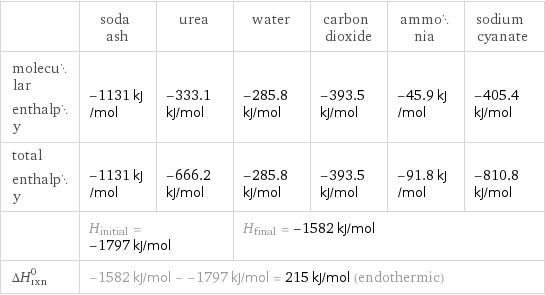Input interpretation

Na_2CO_3 soda ash + NH_2CONH_2 urea ⟶ H_2O water + CO_2 carbon dioxide + NH_3 ammonia + NaOCN sodium cyanate
Balanced equation

Balance the chemical equation algebraically: Na_2CO_3 + NH_2CONH_2 ⟶ H_2O + CO_2 + NH_3 + NaOCN Add stoichiometric coefficients, c_i, to the reactants and products: c_1 Na_2CO_3 + c_2 NH_2CONH_2 ⟶ c_3 H_2O + c_4 CO_2 + c_5 NH_3 + c_6 NaOCN Set the number of atoms in the reactants equal to the number of atoms in the products for C, Na, O, H and N: C: | c_1 + c_2 = c_4 + c_6 Na: | 2 c_1 = c_6 O: | 3 c_1 + c_2 = c_3 + 2 c_4 + c_6 H: | 4 c_2 = 2 c_3 + 3 c_5 N: | 2 c_2 = c_5 + c_6 Since the coefficients are relative quantities and underdetermined, choose a coefficient to set arbitrarily. To keep the coefficients small, the arbitrary value is ordinarily one. For instance, set c_1 = 1 and solve the system of equations for the remaining coefficients: c_1 = 1 c_3 = 3 - c_2 c_4 = c_2 - 1 c_5 = 2 c_2 - 2 c_6 = 2 The resulting system of equations is still underdetermined, so an additional coefficient must be set arbitrarily. Set c_2 = 2 and solve for the remaining coefficients: c_1 = 1 c_2 = 2 c_3 = 1 c_4 = 1 c_5 = 2 c_6 = 2 Substitute the coefficients into the chemical reaction to obtain the balanced equation: Answer: | | Na_2CO_3 + 2 NH_2CONH_2 ⟶ H_2O + CO_2 + 2 NH_3 + 2 NaOCN
Structures

+ ⟶ + + +
Names

soda ash + urea ⟶ water + carbon dioxide + ammonia + sodium cyanate
Reaction thermodynamics
Enthalpy

| soda ash | urea | water | carbon dioxide | ammonia | sodium cyanate molecular enthalpy | -1131 kJ/mol | -333.1 kJ/mol | -285.8 kJ/mol | -393.5 kJ/mol | -45.9 kJ/mol | -405.4 kJ/mol total enthalpy | -1131 kJ/mol | -666.2 kJ/mol | -285.8 kJ/mol | -393.5 kJ/mol | -91.8 kJ/mol | -810.8 kJ/mol | H_initial = -1797 kJ/mol | | H_final = -1582 kJ/mol | | | ΔH_rxn^0 | -1582 kJ/mol - -1797 kJ/mol = 215 kJ/mol (endothermic) | | | | |
Equilibrium constant
![Construct the equilibrium constant, K, expression for: Na_2CO_3 + NH_2CONH_2 ⟶ H_2O + CO_2 + NH_3 + NaOCN Plan: • Balance the chemical equation. • Determine the stoichiometric numbers. • Assemble the activity expression for each chemical species. • Use the activity expressions to build the equilibrium constant expression. Write the balanced chemical equation: Na_2CO_3 + 2 NH_2CONH_2 ⟶ H_2O + CO_2 + 2 NH_3 + 2 NaOCN Assign stoichiometric numbers, ν_i, using the stoichiometric coefficients, c_i, from the balanced chemical equation in the following manner: ν_i = -c_i for reactants and ν_i = c_i for products: chemical species | c_i | ν_i Na_2CO_3 | 1 | -1 NH_2CONH_2 | 2 | -2 H_2O | 1 | 1 CO_2 | 1 | 1 NH_3 | 2 | 2 NaOCN | 2 | 2 Assemble the activity expressions accounting for the state of matter and ν_i: chemical species | c_i | ν_i | activity expression Na_2CO_3 | 1 | -1 | ([Na2CO3])^(-1) NH_2CONH_2 | 2 | -2 | ([NH2CONH2])^(-2) H_2O | 1 | 1 | [H2O] CO_2 | 1 | 1 | [CO2] NH_3 | 2 | 2 | ([NH3])^2 NaOCN | 2 | 2 | ([NaOCN])^2 The equilibrium constant symbol in the concentration basis is: K_c Mulitply the activity expressions to arrive at the K_c expression: Answer: | | K_c = ([Na2CO3])^(-1) ([NH2CONH2])^(-2) [H2O] [CO2] ([NH3])^2 ([NaOCN])^2 = ([H2O] [CO2] ([NH3])^2 ([NaOCN])^2)/([Na2CO3] ([NH2CONH2])^2)](../image_source/697ae7c2c64cae0b2e4f3dc715ba1712.png)
Construct the equilibrium constant, K, expression for: Na_2CO_3 + NH_2CONH_2 ⟶ H_2O + CO_2 + NH_3 + NaOCN Plan: • Balance the chemical equation. • Determine the stoichiometric numbers. • Assemble the activity expression for each chemical species. • Use the activity expressions to build the equilibrium constant expression. Write the balanced chemical equation: Na_2CO_3 + 2 NH_2CONH_2 ⟶ H_2O + CO_2 + 2 NH_3 + 2 NaOCN Assign stoichiometric numbers, ν_i, using the stoichiometric coefficients, c_i, from the balanced chemical equation in the following manner: ν_i = -c_i for reactants and ν_i = c_i for products: chemical species | c_i | ν_i Na_2CO_3 | 1 | -1 NH_2CONH_2 | 2 | -2 H_2O | 1 | 1 CO_2 | 1 | 1 NH_3 | 2 | 2 NaOCN | 2 | 2 Assemble the activity expressions accounting for the state of matter and ν_i: chemical species | c_i | ν_i | activity expression Na_2CO_3 | 1 | -1 | ([Na2CO3])^(-1) NH_2CONH_2 | 2 | -2 | ([NH2CONH2])^(-2) H_2O | 1 | 1 | [H2O] CO_2 | 1 | 1 | [CO2] NH_3 | 2 | 2 | ([NH3])^2 NaOCN | 2 | 2 | ([NaOCN])^2 The equilibrium constant symbol in the concentration basis is: K_c Mulitply the activity expressions to arrive at the K_c expression: Answer: | | K_c = ([Na2CO3])^(-1) ([NH2CONH2])^(-2) [H2O] [CO2] ([NH3])^2 ([NaOCN])^2 = ([H2O] [CO2] ([NH3])^2 ([NaOCN])^2)/([Na2CO3] ([NH2CONH2])^2)
Rate of reaction
![Construct the rate of reaction expression for: Na_2CO_3 + NH_2CONH_2 ⟶ H_2O + CO_2 + NH_3 + NaOCN Plan: • Balance the chemical equation. • Determine the stoichiometric numbers. • Assemble the rate term for each chemical species. • Write the rate of reaction expression. Write the balanced chemical equation: Na_2CO_3 + 2 NH_2CONH_2 ⟶ H_2O + CO_2 + 2 NH_3 + 2 NaOCN Assign stoichiometric numbers, ν_i, using the stoichiometric coefficients, c_i, from the balanced chemical equation in the following manner: ν_i = -c_i for reactants and ν_i = c_i for products: chemical species | c_i | ν_i Na_2CO_3 | 1 | -1 NH_2CONH_2 | 2 | -2 H_2O | 1 | 1 CO_2 | 1 | 1 NH_3 | 2 | 2 NaOCN | 2 | 2 The rate term for each chemical species, B_i, is 1/ν_i(Δ[B_i])/(Δt) where [B_i] is the amount concentration and t is time: chemical species | c_i | ν_i | rate term Na_2CO_3 | 1 | -1 | -(Δ[Na2CO3])/(Δt) NH_2CONH_2 | 2 | -2 | -1/2 (Δ[NH2CONH2])/(Δt) H_2O | 1 | 1 | (Δ[H2O])/(Δt) CO_2 | 1 | 1 | (Δ[CO2])/(Δt) NH_3 | 2 | 2 | 1/2 (Δ[NH3])/(Δt) NaOCN | 2 | 2 | 1/2 (Δ[NaOCN])/(Δt) (for infinitesimal rate of change, replace Δ with d) Set the rate terms equal to each other to arrive at the rate expression: Answer: | | rate = -(Δ[Na2CO3])/(Δt) = -1/2 (Δ[NH2CONH2])/(Δt) = (Δ[H2O])/(Δt) = (Δ[CO2])/(Δt) = 1/2 (Δ[NH3])/(Δt) = 1/2 (Δ[NaOCN])/(Δt) (assuming constant volume and no accumulation of intermediates or side products)](../image_source/63a943fca55edd8962da6d1eb820c7b8.png)
Construct the rate of reaction expression for: Na_2CO_3 + NH_2CONH_2 ⟶ H_2O + CO_2 + NH_3 + NaOCN Plan: • Balance the chemical equation. • Determine the stoichiometric numbers. • Assemble the rate term for each chemical species. • Write the rate of reaction expression. Write the balanced chemical equation: Na_2CO_3 + 2 NH_2CONH_2 ⟶ H_2O + CO_2 + 2 NH_3 + 2 NaOCN Assign stoichiometric numbers, ν_i, using the stoichiometric coefficients, c_i, from the balanced chemical equation in the following manner: ν_i = -c_i for reactants and ν_i = c_i for products: chemical species | c_i | ν_i Na_2CO_3 | 1 | -1 NH_2CONH_2 | 2 | -2 H_2O | 1 | 1 CO_2 | 1 | 1 NH_3 | 2 | 2 NaOCN | 2 | 2 The rate term for each chemical species, B_i, is 1/ν_i(Δ[B_i])/(Δt) where [B_i] is the amount concentration and t is time: chemical species | c_i | ν_i | rate term Na_2CO_3 | 1 | -1 | -(Δ[Na2CO3])/(Δt) NH_2CONH_2 | 2 | -2 | -1/2 (Δ[NH2CONH2])/(Δt) H_2O | 1 | 1 | (Δ[H2O])/(Δt) CO_2 | 1 | 1 | (Δ[CO2])/(Δt) NH_3 | 2 | 2 | 1/2 (Δ[NH3])/(Δt) NaOCN | 2 | 2 | 1/2 (Δ[NaOCN])/(Δt) (for infinitesimal rate of change, replace Δ with d) Set the rate terms equal to each other to arrive at the rate expression: Answer: | | rate = -(Δ[Na2CO3])/(Δt) = -1/2 (Δ[NH2CONH2])/(Δt) = (Δ[H2O])/(Δt) = (Δ[CO2])/(Δt) = 1/2 (Δ[NH3])/(Δt) = 1/2 (Δ[NaOCN])/(Δt) (assuming constant volume and no accumulation of intermediates or side products)
Chemical names and formulas

| soda ash | urea | water | carbon dioxide | ammonia | sodium cyanate formula | Na_2CO_3 | NH_2CONH_2 | H_2O | CO_2 | NH_3 | NaOCN Hill formula | CNa_2O_3 | CH_4N_2O | H_2O | CO_2 | H_3N | CNNaO name | soda ash | urea | water | carbon dioxide | ammonia | sodium cyanate IUPAC name | disodium carbonate | urea | water | carbon dioxide | ammonia | sodium cyanate